NCERT Exemplar Class 11 Physics Chapter 6 System of Particles and Rotational Motion are part of NCERT Exemplar Class 11 Physics . Here we have given NCERT Exemplar Class 11 Physics Chapter 6 System of Particles and Rotational Motion.
N CERT Exemplar Class 11 Physics Chapter 6 System of Particles and Rotational Motion
Multiple Choice Questions
Single Correct Answer Type
Q1. For which of the following does the centre of mass lie outside the body?
(a) A pencil (b) Ashotput
(c) A dice (d) A bangle
Sol
: (d) .
Key concept: Center of mass of a system (body) is a point that moves as though all the mass were concentrated there and all external forces were applied there.
Important Points about Center of Mass:
(i) The position of center of mass is independent of the co-ordinate system chosen.
(ii) The position of center of mass depends upon the shape of the body and distribution of mass.
Example: The center of mass of a circular disc is within the material of the body while that of a circular ring is outside the material of the body.
(iii) We can imagine a rigid body also as a system of masses and hence every rigid body has a center of mass. In case of a regularly shaped uniform rigid body, center of mass is simply the geometric centre of the body.
A bangle is in the form of a ring as shown in the diagram below. We know that the position of center of mass depends upon the shape of the body and distribution of mass. So, out of four given bodies, the centre of mass lies at the centre, which is outside the body (boundary) whereas in all other three bodies it lies within the body because they are completely solid.

Q2. Which of the following points is the likely position of Hollow
the centre of mass of the system shown in figure? sphere
(a) A
(b) B
(c) C
(d) D
Sol:
(c) The position of centre of mass of the system in this problem is closer to heavier mass or masses or we can say that it depends upon distribution of mass. So it is likely to be at C. In the above diagram, lower part of the sphere containing sand is more heavier than upper part containing air. Hence CM of the system lies below the horizontal diameter.
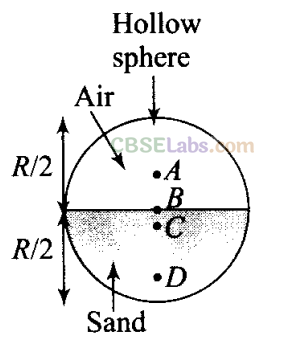
Q3. A particle of mass m is moving in yz-plane with a uniform velocity v with its trajectory running parallel to +ve y-axis and intersecting z-axis at z = a in figure. The change in its angular momentum about the origin as it bounces elastically from a wall at y = constant is
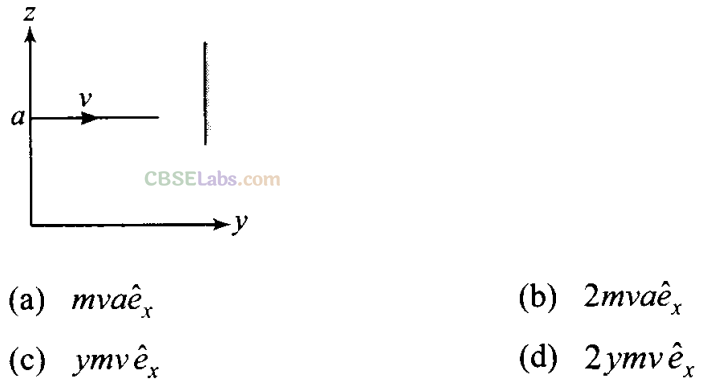
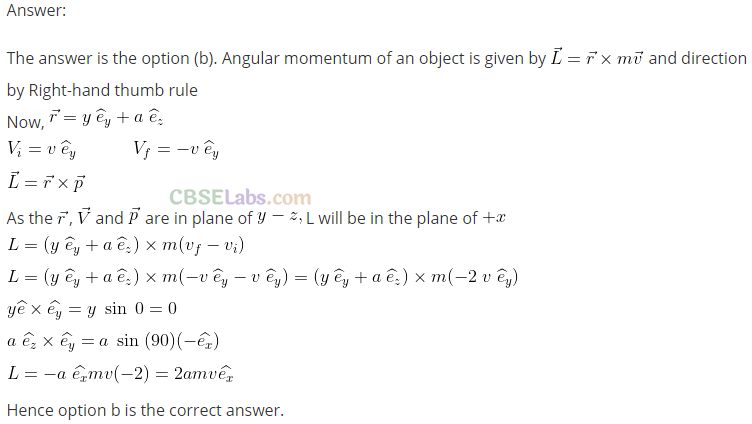 =
=
Q4. When a disc rotates with uniform, angular velocity, which of the following is not true?
(a) The sense of rotation remains same.
(b) The orientation of the axis of rotation remains same.
(c) The speed of rotation is non-zero and remains same.
(d) The angular acceleration is non-zero and remains same.
Sol:
(d)
Key concept: The rate of change of angular velocity is defined as angular acceleration. If particle has angular velocity ω
1
at time
t
1
, and angular velocity ω
2
at time t
2
, then
Angular acceleration α = ω
2
– ω
1
/ t
2
– t
1
When the disc is rotated with constant angular velocity, angular acceleration of the disc is zero. Because we know that angular acceleration
α = ∆ ω/∆ t
Here ω is constant, so ∆ ω = 0
Q5. A uniform square plate has a small piece Q of an irregular shape removed and glued to the centre of the plate leaving a hole behind in figure. The moment of inertia about the z-axis is then
(a) increased
(b) decreased
(c) the same
(d) changed in unpredicted manner
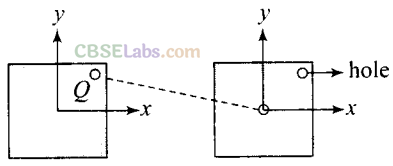
Q6. In problem 5, the CM of the plate is now in the following quadrant of x-y plane.
(a) I (b) II (c) III (d) IV
Sol:
(c) Let us consider the diagram below, which shows the position of the piece which is removed from the plate. First center of mass is at the centre of the plate (only if its mass is uniformly distributed over the surface) when the piece is removed from quadrant I, therefore the centre of mass is shifted to the
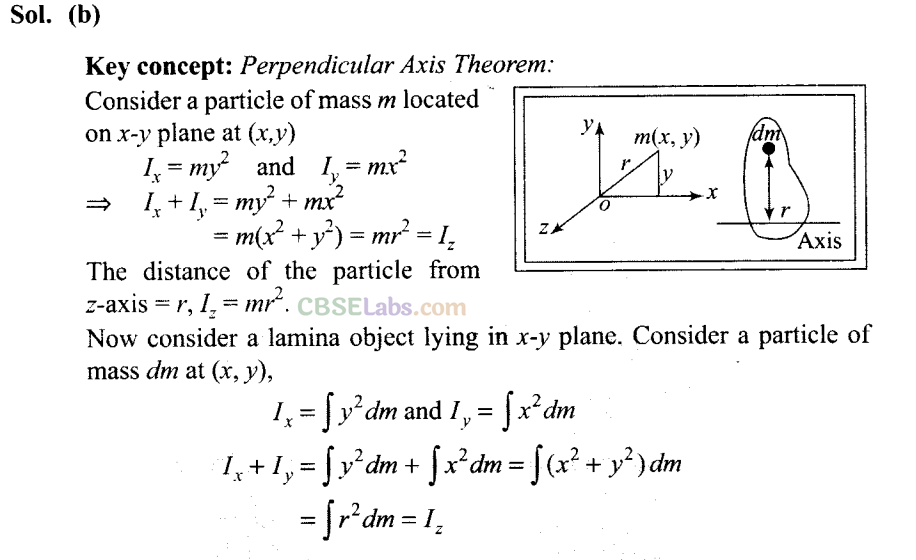
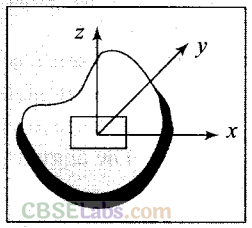
The sum of moments of inertia of a laminar object about two mutually perpendicular axes lying in the plane of lamina is equal to the moment of inertia about an axis normal to the plane of the lamina and passing through the two perpendicular axes. This theorem is applicable only for laminar (thin sheet kind of) object.
I x and I y both decreases with the hole. Gluing the removed piece at the centre of the square plate does not affect I z . The mass comes closer to the z-axis, hence, moment of inertia decreases overall about z-axis.
Q6. In problem 5, the CM of the plate is now in the following quadrant of x-y plane.
(a) I (b) II (c) III (d) IV
Sol:
(c) Let us consider the diagram below, which shows the position of the piece which is removed from the plate. First center of mass is at the centre of the plate (only if its mass is uniformly distributed over the surface) when the piece is removed from quadrant I, therefore the centre of mass is shifted to the
opposite of the quadrant III.

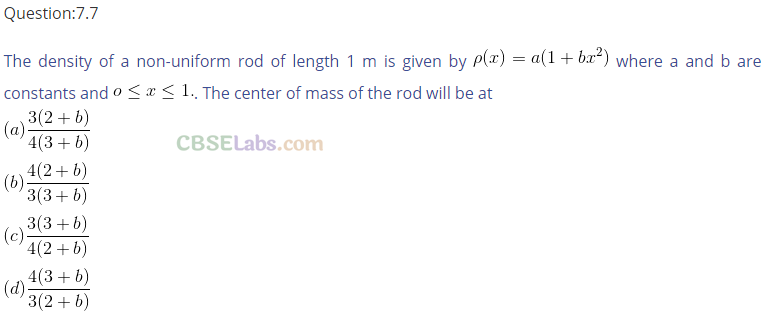
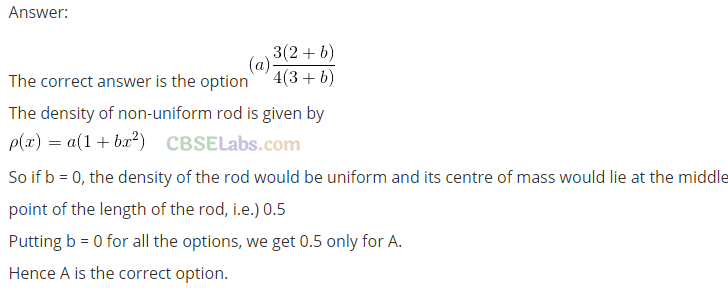
Q8. A merry-go-round, made of a ring-like platform of radius R and mass M, is revolving with angular speed ω. A person of mass Mis standing on it. At one instant, the person jumps off the round, radially away from the centre of the round (as seen from the round). The speed of the round afterwards is
(a) 2 ω
(b) ω
(c) ω/2
(d) 0
Sol:
(b)As no torque is exerted by the person jumping, radially away from the centre of the round (as seen from the round), let the total moment of inertia of the system is 2I (round + Person (because the total mass is 2M) and the round is revolving with angular speed ωSince the angular momentum of the person when it jumps off the round is Iω the actual momentum of round seen from ground is 2 Iω – Iω = Iω
So we conclude that the angular speed remains same, i.e ω
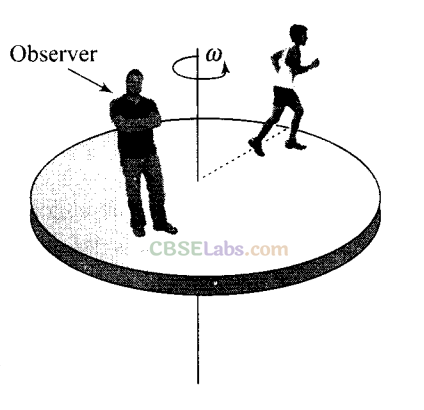
More Than One Correct Answer Type
Q9. Choose the correct alternatives:
(a) For a general rotational motion, angular momentum L and angular velocity ω need not be parallel.
(b) For a rotational motion about a fixed axis, angular momentum L and angular velocity ωare always parallel.
(c) For a general translational motion, momentum p and velocity v are always parallel.
(d) For a general translational motion, acceleration a and velocity v are always parallel.
Sol:
(a, c) .
(a) For a general rotational motion where axis of rotation is not symmetric. Angular momentum Z and angular velocity 0) need not be parallel. The wobbly motion of a wheel rotating about an axis inclined at a small angle to the symmetry axis of the wheel represents a situation where angular momentum and angular velocity are not parallel.
(b) Fixed axis should pass through CM of the body, so it is not necessary angular momentum Z and angular velocity ω are always parallel.
(c) As we know in a general translational motion linear momentum is given by, p = mv , hence, direction of p is always along v .
(d) In projectile motion, v and a are not always parallel.
Q10. Figure shows two identical particles 1 and 2, each of mass m, moving in opposite directions with same speed v along parallel lines. At a particular
instant
r
1
and r
2
are their respective position vectors drawn from point A which is in the plane of the parallel lines. Choose the correct options:
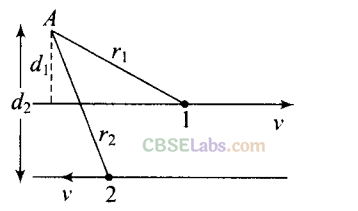
Figure shows two identical particles 1 and 2, each of mass m, moving in opposite directions with same speed v along parallel lines. At a particular instant r
1
and r
2
are their respective position vectors drawn from point A which is in the plane of the parallel lines. Choose the correct options:

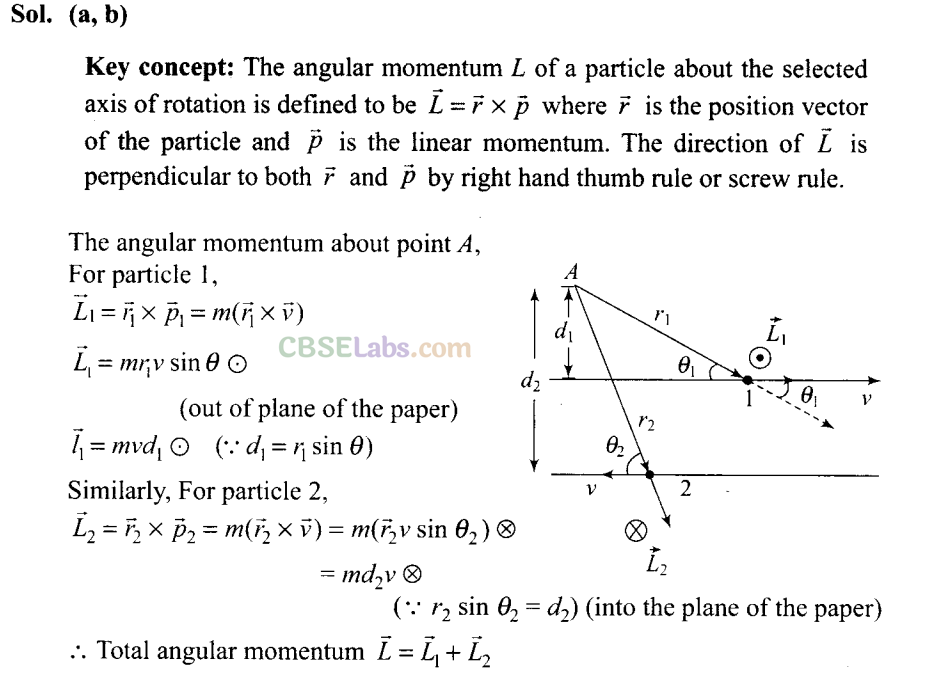
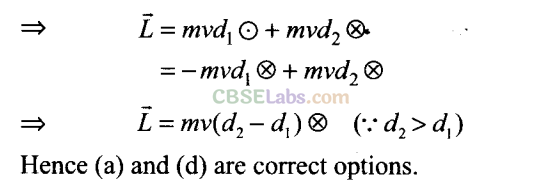
Q11. The net external torque on a system of particles about an axis is zero. Which of the following are compatible with it?
(a) The forces may be acting radially from a point on the axis.
(b) The forces may be acting on the axis of rotation.
(c) The forces may be acting parallel to the axis of rotation.
(d) The torque caused by some forces may be equal and opposite to that caused by other forces.
Sol:
(a, b, c, d)
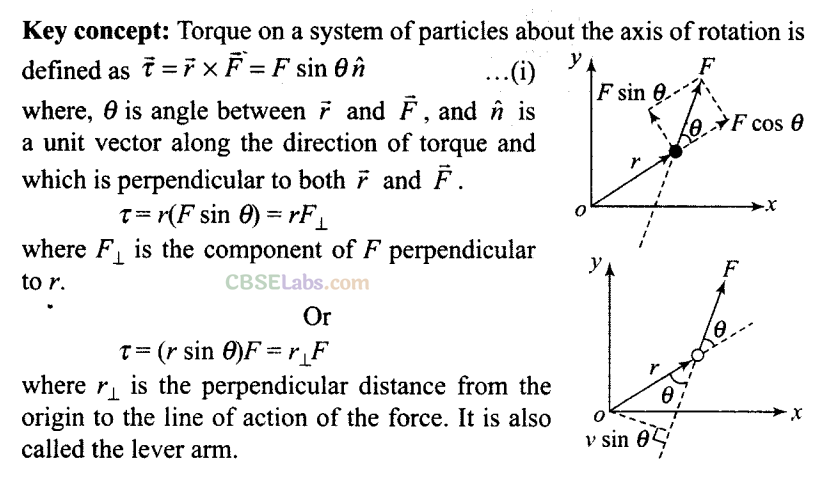

Important point: To get the direction where you can use right hand rule: Place the fingers of right hand along r and then curl them into F through the smaller angle between them, n is directed along the (stretched) thumb. For involving two dimensions only, can be replaced by sense of rotation, clockwise or anticlockwise; if the fingers of the right hand curl (while going from clockwise, torque is taken as clockwise and when they curl anticlockwise torque is taken as anticlockwise.)
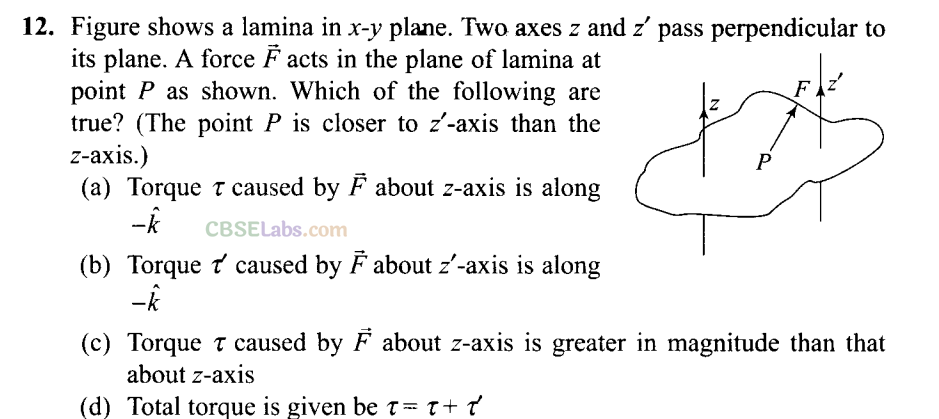
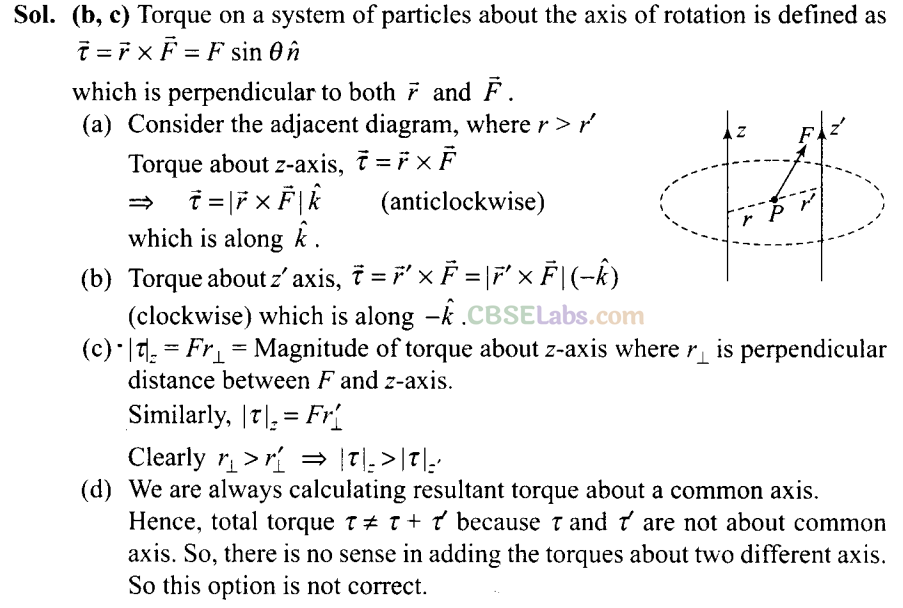
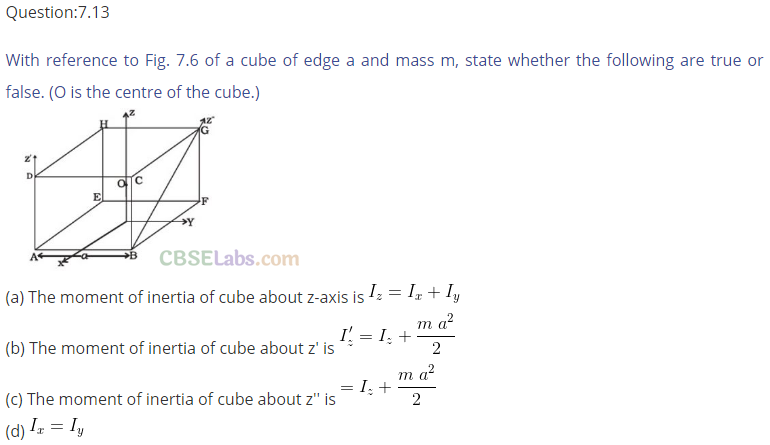
Sol:
(b, d) We can apply the concept of symmetry to calculate the net moment of inertia. Moment of inertia about two symmetrical axes are same.
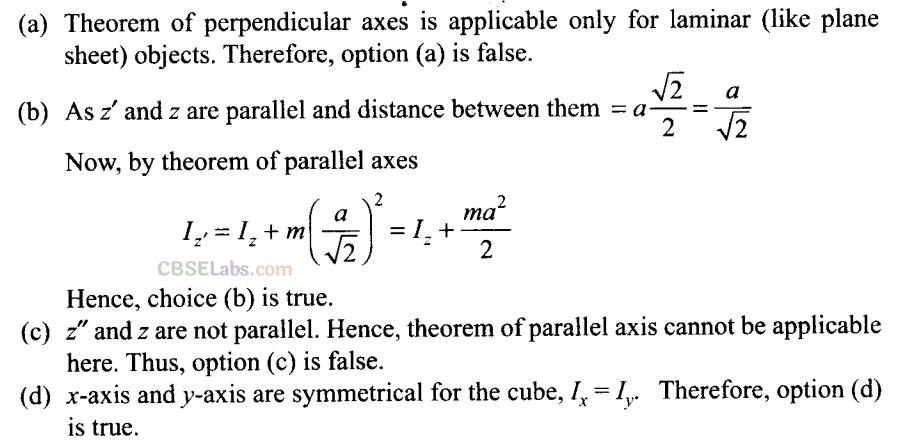
Very Short Answer Type Questions
Q14. The centre of gravity of a body on the earth coincides with its centre of mass for a small object whereas for an extended object it may not. What is the qualitative meaning of small and extended in this regard? For which of the following two coincides—A building, a pond, a lake, a mountain?
Sol:
Key concept: The center of gravity of a body is that point through which the resultant of the system of parallel forces formed by the weights of all the particles constituting the body passes for all positions of the body. It is denoted as “C.G.” or “G”.
Centre of gravity is centre of a given structure but centre of mass is a point where whole mass of the body can be assumed to be concentrated.
An object is said to be small if its vertical height is very small compared to the radius of the earth, otherwise it is extended.
Building and ponds are small objects so their CG coincides with CM, while a deep lake and a mountain can be considered as extended objects, so the CG does not coincide in their CM.
Q15. Why does a solid sphere have smaller moment of inertia than a hollow cylinder of same mass and radius, about an axis passing through their axes of symmetry?
Sol:
Key concept: Moment of inertia of a particle l = mr
2
where r is the perpendicular distance of particle from rotational axis.
Moment of inertia of a body made up of number of particles (discrete distribution)
I = m
1
r
1
2
+ m
2
r
2
2
+ m
3
r
3
2
Moment of inertia of a continuous distribution of mass, treating the element of mass dm at position r as particle
dl = dmr
2
MI is not constant for a body. It depends on the axis of rotation.
MI depends on the mass of the body. The higher the mass, higher the MI.
MI depends on the distribution of the mass about an axis. The farther the mass is distributed from the axis, higher will be the MI.
Moment of inertia depends on mass, distribution of mass and on the position of axis of rotation.
All the mass in a cylinder lies at distance R from the axis of symmetry but most of the mass of a solid sphere lies at a smaller distance than R. Therefore,
I
hollowcylinder
> I
sphere
Q16. The variation of angular position , of a point on a rotating rigid body, with time t is shown in
figure
. Is the body rotating clockwise or anti-clockwise?
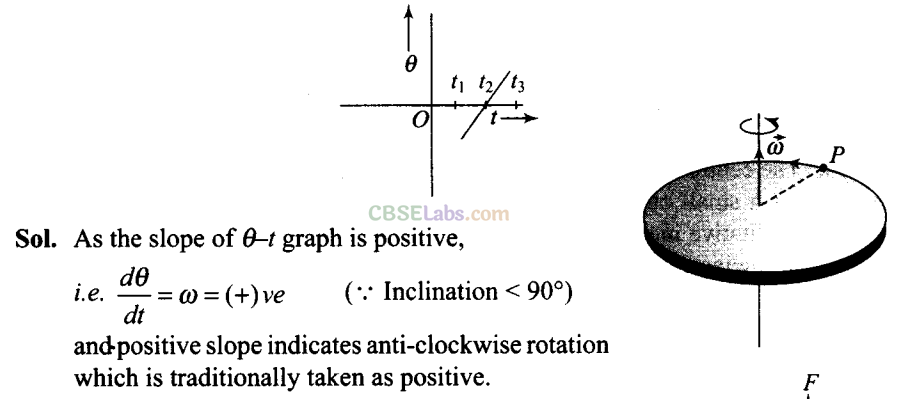
Q17. A uniform cube of mass m and side a is placed on a frictionless horizontal surface. A vertical force F is applied to the edge as shown in
figure
. Match the following (most appropriate choice).
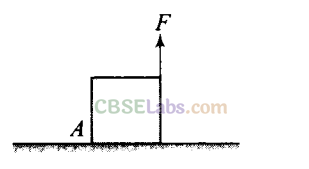
| Column I | Column 11 | ||
| (a) | mg/4 <F< mg/2 | (i) | Cube will move up. |
| (b) | F > mg/2 | (ii) | Cube will not exhibit motion. |
| (c) | F> mg | (iii) | Cube will begin to rotate and slip at A. |
| (d) | F = mg/4 | (iv) | Normal reaction effectively at a/3 from A, no motion. |
Sol: Let us first consider the below diagram torque or moment of the force F about point A is given by l =aF
This is anticlockwise.
Torque of weight mg about A,
2
= q/2
This is clockwise.
N is acting at point A. So, torque due to normal reaction about A will be zero. There is no motion in cube if
1
=
2
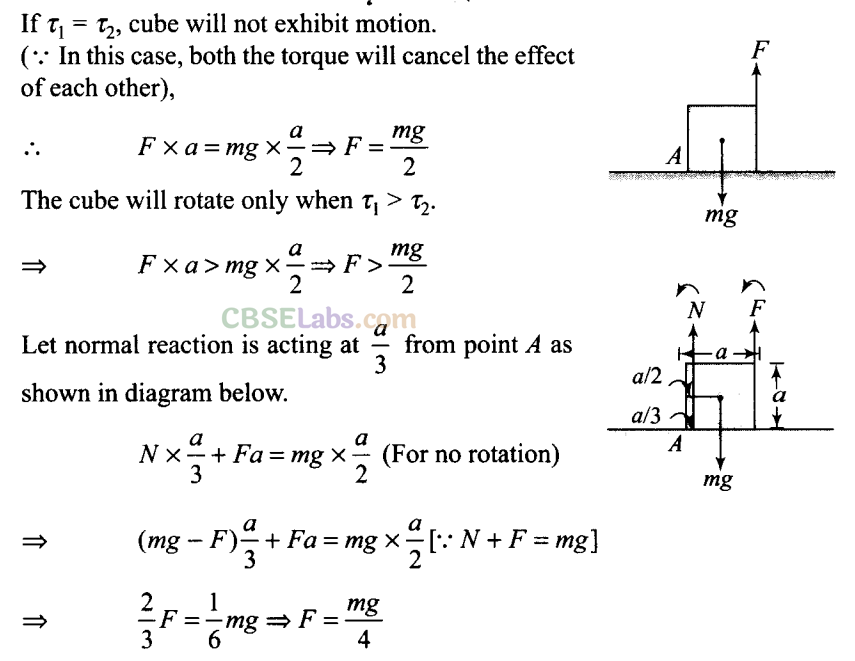
(a) → (ii)
(b) → (iii)
(c) → (i)
(d) → (iv)
Q18. A uniform sphere of mass m and radius R is placed on a rough horizontal surface (figure). The sphere h is struck horizontally at a height h from the floor. ,, Match the following.
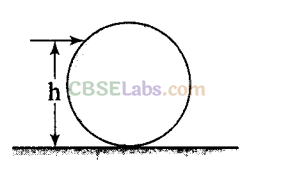
| Column 1 | Column II | ||
| (a) | h =R/2 | (0 | Sphere rolls without slipping with a constant velocity and no loss of energy. |
| (b) | h = R | (ii) | Sphere spins clockwise, loses energy by friction |
| (c) | h = 3R/2 | (iii) | Sphere spins anti-clockwise, loses energy by friction. |
| (d) | h = 1R!5 | (iv) | Sphere has only a translational motion, looses energy by friction. |
Sol:
Mass of the sphere = m
Radius = R
h = height from the floor
The sphere will roll without slipping when
ω = V/R
where, v is linear velocity and to is angular velocity of the sphere.
Now, angular momentum of sphere, about centre of mass [We are applying conservation of angular momentum just before and after struck.]
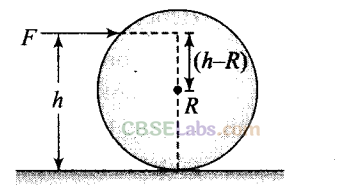
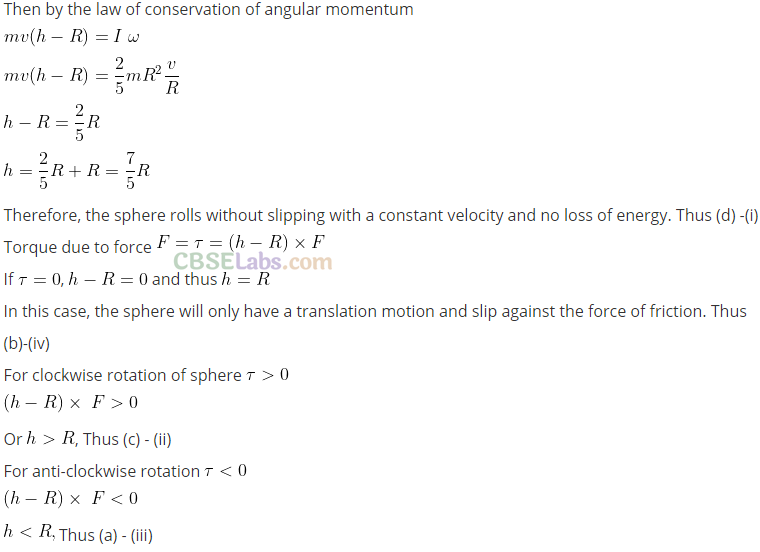
Short Answer Type Questions
Q19. The vector sum of a system of non-collinear forces acting on a rigid body is given to be non-zero. If the vector sum of all the torques due to the system of forces about a certain point is found to be zero, does this mean that it is necessarily zero about any arbitrary point?
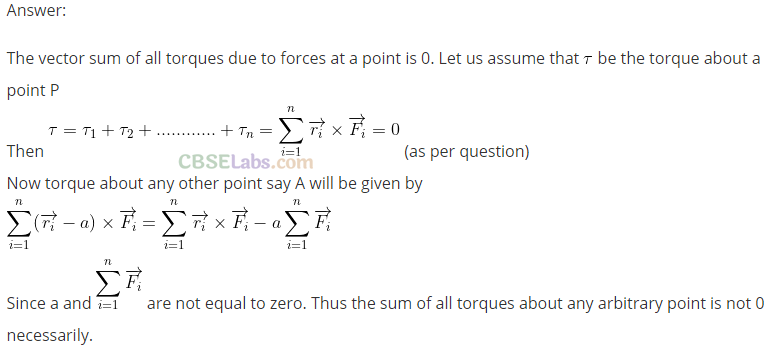
Q20. A wheel in uniform motion about an axis passing through its centre and perpendicular to its plane is considered to be in mechanical (translational plus rotational) equilibrium because no net external force or torque is required to sustain its motion. However, the particles that constitute the wheel do experience a centripetal acceleration directed towards the centre. How do you reconcile this fact with the wheel being in equilibrium?How would you set a half-wheel into uniform motion about an axis passing through the centre of mass of the wheel and perpendicular to its plane? Will you require external forces to sustain the motion?
Sol:
Internal elastic forces gives rise to the centripetal acceleration of its particles in a wheel. These forces are in pairs and cancel each other because they are part of a symmetrical system.
In a half wheel, the distribution of mass about its centre of mass (through which axis of rotation passes) is not symmetrical. Therefore, the direction of angular momentum of the wheel does not coincide with the direction of its angular velocity. Hence, an external torque is required to maintain the motion of the half wheel.
Q21. A door is hinged at one end and is free to rotate about a vertical axis (figure). Does its weight cause any torque about this axis? Give
reason
for your answer.
Sol:
According to the diagram, where weight of the door acts along negative y-axis.
Torque is not produced by weight about y-axis.
Because the direction of weight is parallel to y-axis (axis of rotation).
A force can produce torque only along direction normal to itself because f = r x F. So, when the door is in the xy-plane, the torque produced by gravity can only be along ±z-direction never about an axis passing through y-direction.
Hence, the weight will not produce any torque about y-axis.
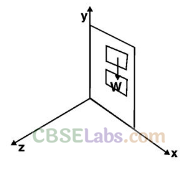
Q22. (n – 1) equal point masses each of mass m are placed at the vertices of a regular n-polygon. The vacant vertex has a position vector a with respect to the centre of the polygon. Find the position vector of centre of mass.
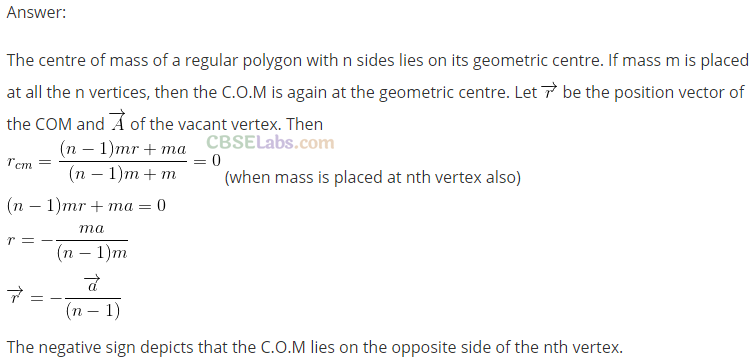
Hence the center of mass of n particles is a weighted average of the position vectors of n particles making up the system.
The centre of mass of a regular n-polygon lies at its geometrical centre.
Let position vector of each centre of mass or regular n polygon is r .
(n – 1) equal point masses each of mass m are placed at (n – 1) vertices of the regular n-polygon, therefore, for its centre of mass.
Long Answer Type Questions
Q23. Find the centre of mass of a uniform (a) half-disc, (b) quarter-disc.
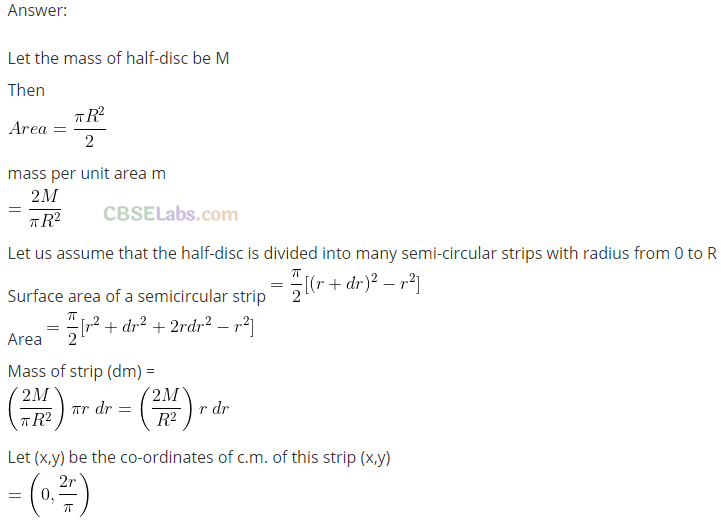
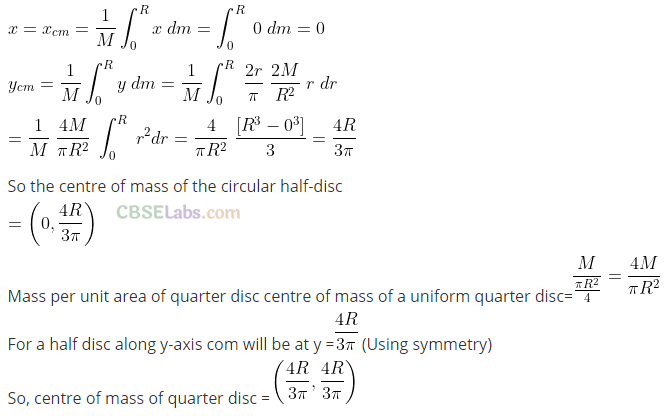
The half-disc can be supposed to be consisted of a large number of semicircular rings, so let us consider an element (which is a semi-circular rings) of this disc between r and (r + dr) of mass dm and thickness dr and radii ranging or limiting from r = 0 to r = R.
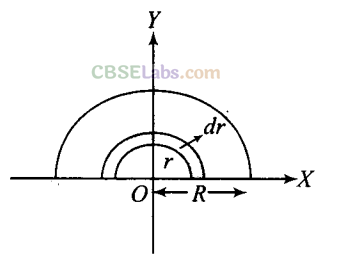
Q24. Two discs of moments of inertia I 1 , and I 2 about their respective axes (normal to the disc and passing through the centre), and rotating with angular speed ω 1 and ω 2 and are brought into contact face to face with their axes of rotation coincident.
(a) Does the law of conservation of angular momentum apply to the situation? Why?
(b) Find the angular speed of the two discs system.
(c) Calculate the loss in kinetic energy of the system in the process.
(d)Account for this loss.
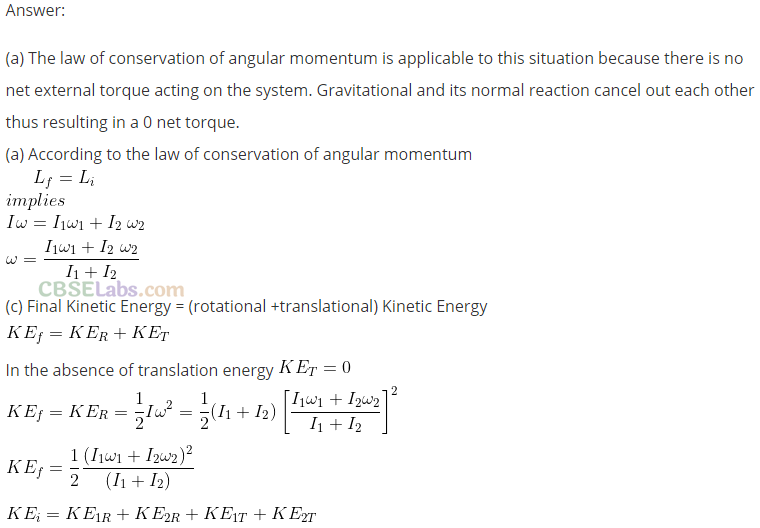
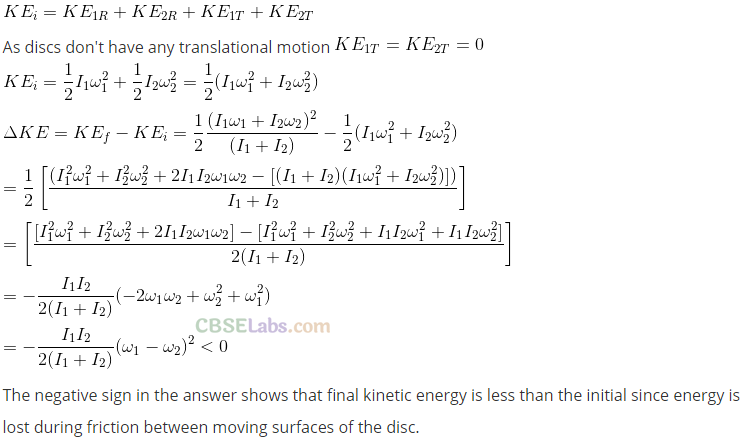
Q25. A disc of radius R is rotating with an angular co0 about a horizontal axis. It is placed on a horizontal table. The coefficient of kinetic friction is jJ.K.
(a) What was the velocity of its centre of mass before being brought in contact with the table?
(b) What happens to the linear velocity of a point on its rim when placed in contact with the table?
(c) What happens to the linear speed of the centre of mass when disc is placed in contact with the table?
(d) Which force is responsible for the effects in (b) and (c)?
(e) What condition should be satisfied for rolling to begin?
(f) Calculate the time taken for the rolling to begin.
Sol:
Key concept:
When the axis of rotation is not fixed (Stationary in space), the motion of a rigid body is considered as combination of motion of centre of mass plus a rotation about centre of mass. The two components of motion are described by
![]()
How the translational motion and rotational motion about the centre of mass are superimposed to get the motion of a rigid body (say a disc of radius R) are illustrated in the following figures.

To get the instantaneous velocity of any point on the rigid body, we calculate the instantaneous velocity of that point in pure translation and in pure rotation and add them vectorially.
(a) Disc is rotating only about its horizontal axis before being brought in contact with the table. Hence its CM is at rest; v
CM
= 0
(b) When the disc is placed in contact with the table due to friction velocity of a point on the rim
(c) Linear speed of the CM of disc increases when disc is placed in contact with the table, because its acceleration becomes
a
CM
=
k
g
(d) Friction is responsible for the effects in (b) and (c) because friction is disturbing the velocity of the point which is in contact with table, hence velocity at all the points of disc is disturbed
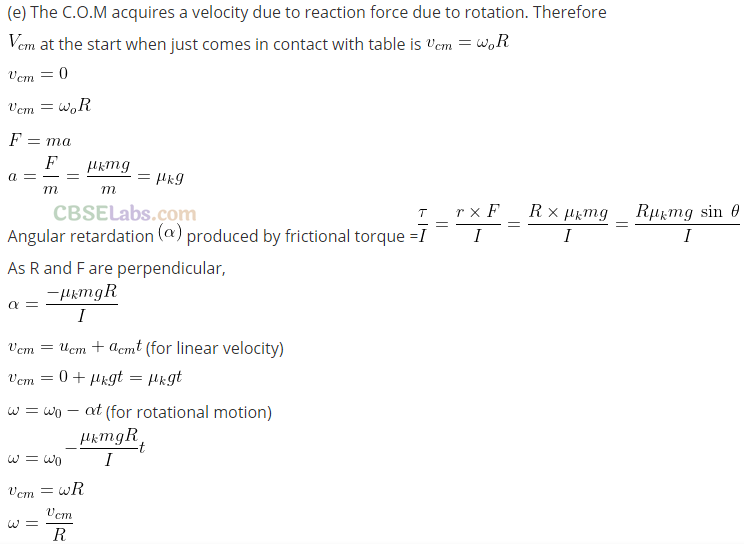
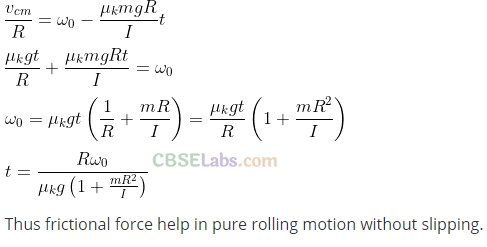
Important point: In pure rolling motion, frictional force will support. Or we can say that it just opposes the relative motion of point of contact at any instant.
Q26. Two cylindrical hollow drums of radii R and 2R, and of a common height h, are rotating with angular velocities (anti-clockwise) and (clockwise), respectively. Their axes, fixed are parallel and in a horizontal plane separated by (3R + ). They are now brought in contact ( → 0).
(a) Show the frictional forces just after contact.
(b) Identify forces and torques external to the system just after contact.
(c) What would be the ratio of final angular velocities when friction ceases?
Sol:
(a) The frictional forces acting between two cylindrical hollow drums are as shown in the diagram below.
Force F upward shows the friction force on left drum.
Force F downward shows the friction force on right drum.
(b) F
1
= F =F” where F
1
and F” are external forces through support.
=> F
net
= 0 (one each cylinder)
Net external torque to the system about any axis=Fx3R, anticlockwise
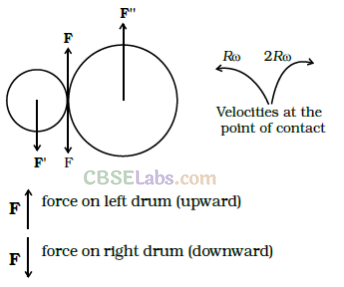
(c) Let
l
and
2
be final angular velocities of smaller and bigger drum respectively (anticlockwise and clockwise respectively).
Finally, there will be no friction. When friction ceases at the point of contact, then both drums has equal linear velocity at that point.
V
A =
V
B
Hence, R
l
= 2R
2
⇒
l
/
2
= 2
Important point : Friction force just opposes the relative motion of point of contacts at any instant. So, we should be very careful while indicating direction of frictional forces.
Q27. A uniform square plate S (side c) and a uniform rectangular plate R (sides b, a) have identical areas and masses.
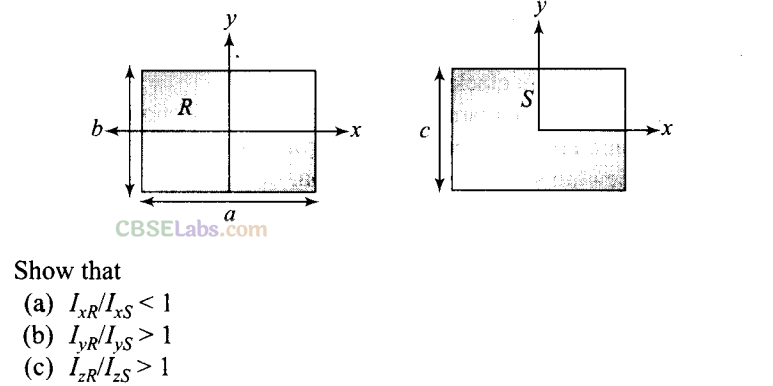
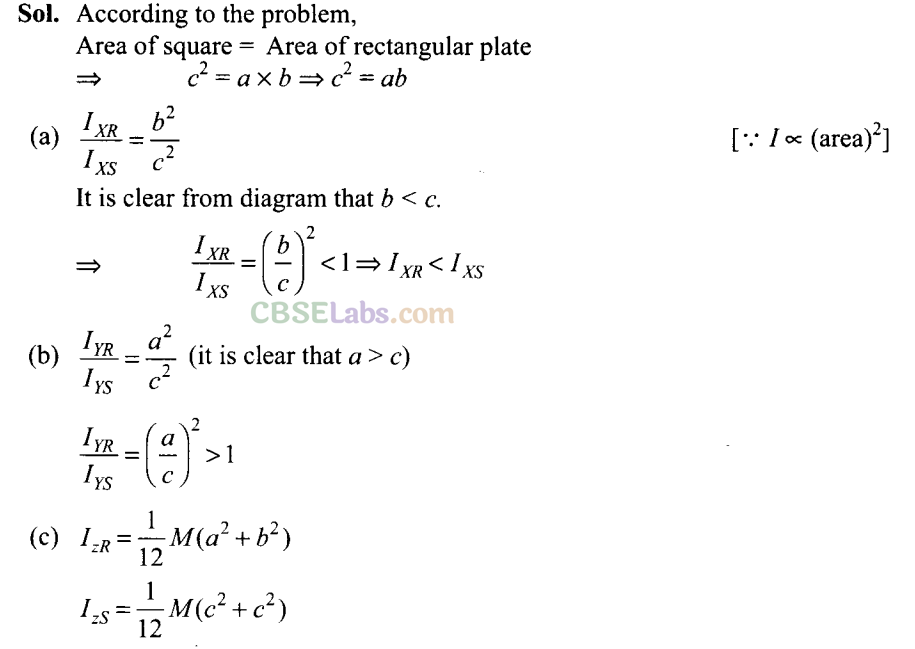
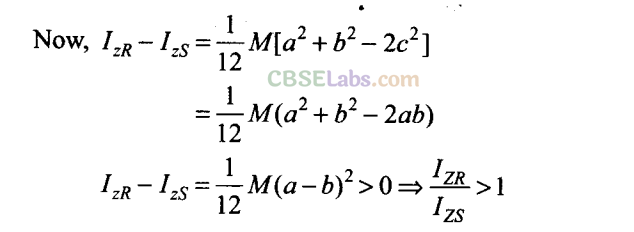
Q28. A uniform disc of radius
R,
is resting on a table on its rim. The coefficient of friction between disc and table is μ
, (Figure). Now, the disc is pulled with a force F as shown in the figure. What is the maximum value of F for which the disc rolls without slipping?
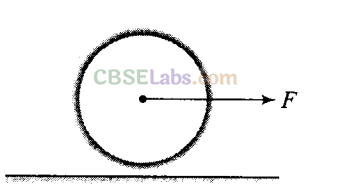
Sol:
In this problem friction force on the disc will act in opposite direction of F at the point which in contact with surface at any instant of time and supports the rotation of the disc in clockwise direction.
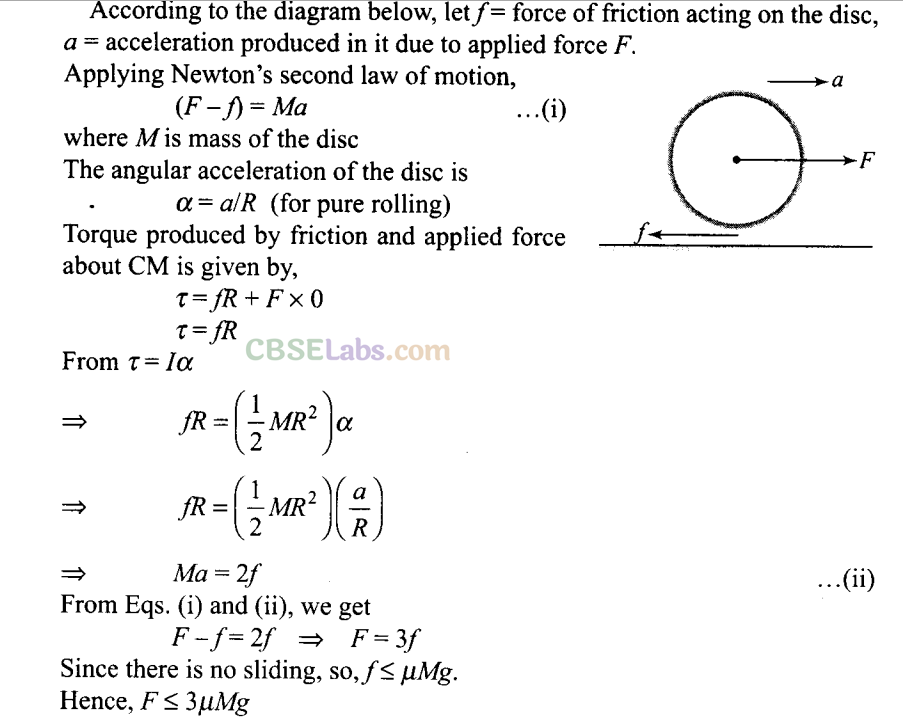
NCERT Exemplar Class 11 Physics Solutions
- Chapter 1 Units and Measurements
- Chapter 2 Motion in a Straight Line
- Chapter 3 Motion in a Plane
- Chapter 4 Laws of Motion
- Chapter 5 Work, Energy and Power
- Chapter 6 System of Particles and Rotational Motion
- Chapter 7 Gravitation
- Chapter 8 Mechanical Properties of Solids
- Chapter 9 Mechanical Properties of Fluids
- Chapter 10 Thermal Properties of Matter
- Chapter 11 Thermodynamics
- Chapter 12 Kinetic Theory
- Chapter 13 Oscillations
- Chapter 14 Waves